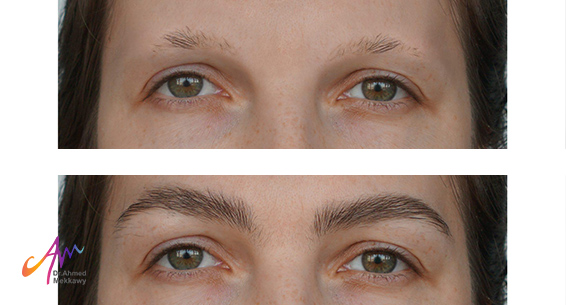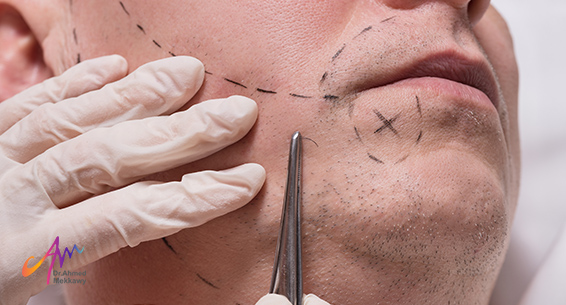Follicular Unit Extraction (FUE)
.jpg)
Follicular Unit Extraction (FUE)
Baldness is a distressing issue that causes embarrassment for many individuals. Hair is a crucial aesthetic element, essential for both men and women alike. Let's talk about its causes and effective treatment methods, like the FUE hair transplant procedure, with Dr. Ahmed Mekkawy through this article.
Causes of hair loss in men and women:
- Deficiency in hair-nourishing vitamins and following an imbalanced diet.
- Anemia, particularly in women during pregnancy, childbirth, and breastfeeding periods.
- Frequent use of chemical hair dyes and hairstyling products leads to hair weakening.
- Overexposure or inadequate exposure to water for prolonged periods.
How to treat hair loss and prevent baldness?
- Obtain sufficient hair-nourishing vitamins after consulting a physician.
- Minimize the use of heat-dependent hairstyling products.
- Specialized treatments like plasma injection sessions or mesotherapy can strengthen hair, prevent loss, and protect against baldness.
Now that we've learned about the causes of hair loss and how to prevent it, let's explore the process of Follicular Unit Extraction (FUE) hair transplants for both men and women.
What is Natural Hair Transplantation?
Natural hair transplantation involves extracting hair follicles from the back of the head and transplanting them to the balding areas at the front of the head.
Follicular Unit Extraction (FUE) Hair Transplant:
FUE hair transplant is one of the latest techniques used to combat hair loss and genetic baldness.
What is FUE Hair Transplantation?
It involves individually extracting hair follicles from the back of the head using the FUE method and re-implanting them in areas experiencing hair loss or baldness. This technique stands out for not requiring surgical incisions and leaving behind no scars or wounds.
Candidates for FUE Hair Transplantation:
- The person should be in good health and not suffer from any chronic conditions that might hinder the hair transplant procedure.
- The person should be a non-smoker or be willing to avoid smoking before and during the recovery period after hair transplantation.
- The causes of hair loss should not be chronic, meaning the person does not suffer from any chronic conditions that could lead to hair loss after transplantation.
- The person should possess sufficient hair density to cover the areas that have experienced baldness.
Preparation Guidelines Before FUE Hair Transplantation:
- Completely avoid smoking before and during the recovery period after hair transplantation.
- Avoid blood thinning medications, such as aspirin, to prevent the risk of bleeding.
- Avoid alcohol and caffeine consumption.
- Ensure the cleanliness of the scalp by washing and drying it thoroughly before hair transplantation.
- Avoid applying cosmetics or creams to the hair before the procedure.
- The doctor may prescribe certain tests and examinations before the hair transplant and might adjust some medications and treatments before the procedure.
Steps of FUE Hair Transplantation:
First: Preparation Phase:
- Dr. Ahmed Mekkawy identifies the areas from which hair follicles are extracted.
- The areas for hair transplantation are determined, along with the number of follicles for extraction.
- Local or general anesthesia is administered to the patient, depending on the case.
This phase takes approximately an hour.
Second: Extraction Phase
- The scalp is sterilized for the extraction of hair follicles.
- Dr. Ahmed Mekkawy works on extracting hair follicles from the donor area at the back of the head. These follicles are extracted one by one.
This phase takes several hours.
Third: Transplantation Phase:
- Tiny incisions are made for the transplantation of the extracted hair follicles.
- Dr. Ahmed Mekkawy implants the extracted hair follicles into these incisions, one by one.
- This phase also takes several hours.
Recovery Period and Post-FUE Hair Transplantation Guidelines:
This technique does not require a lengthy recovery period. Patients can return to their normal activities after a few days. It is essential, however, to follow specific guidelines for achieving the best possible results.
- Avoid smoking during the recovery period, as smoking can constrict veins and arteries, limiting blood flow to the scalp. Inadequate blood supply may lead to insufficient nourishment for the transplanted hair follicles, potentially hindering their growth and even causing their demise.
- Avoid engaging in vigorous physical activities to ensure adequate blood flow to the scalp and proper nourishment for the transplanted hair follicles.
- Ensure an intake of plenty of vitamins and proteins to provide sufficient nutrients for the hair follicles.
- Avoid scratching or rubbing the scalp during the recovery period to achieve the desired outcomes.
Duration of the FUE Hair Transplantation Procedure:
The procedure typically takes between 5 and 8 hours, depending on the case, the number of follicles to be transplanted, and the extent of the areas to be treated for hair loss and baldness.
Results of FUE Hair Transplantation:
The results of FUE hair transplantation start to become visible within six to eight months. After temporary shedding in the first few weeks, the hair begins to regrow, this time permanently. Over the coming months, swelling subsides, bruising fades gradually, and the transplanted follicles stabilize in their new location. Once the follicles have fully stabilized, they continue growing as a natural part of the transplanted area, allowing for normal hair styling and cutting without concern.
Advantages of FUE Hair Transplantation:
- The transplanted hair grows naturally, and it can be cut or styled normally afterward.
- The procedure restores hair in the treated areas in a single session.
- Local anesthesia is typically sufficient for the procedure.
- No scarring or wounds are left behind.
- The recovery period usually lasts only a few days.
- The aim is to rejuvenate appearance, eliminate gaps, and address baldness concerns.
- The results of the transplantation are permanent; it effectively addresses hair loss and baldness issues.
Are There Risks to FUE Hair Transplantation?
- There are no significant risks as the procedure is performed under local anesthesia.
- The risk of infection is minimal and can be managed with antibiotics.
- Mild swelling in the frontal area may occur and gradually subside.
Uses of FUE Hair Transplantation:
Hair Transplantation for Women:
FUE hair transplantation is considered one of the best techniques for women's hair restoration. It doesn't require surgical incisions or leave scars, making it suitable for treating hair thinning, especially after pregnancy and breastfeeding, as well as enhancing the frontal hairline or overall hair density.
Many women go for FUE to thicken the frontal hairline, particularly after it recedes and becomes less dense.
Beard Hair Transplantation:
This technique is also used for beard hair transplantation, as it leaves no scars. Beard transplantation requires high precision to avoid any visible marks after the procedure.
Results of beard hair transplantation appear after several months and look natural, without any noticeable indications of transplantation, bruises, or scars in the treated area. Beard hair continues growing naturally afterward without the need for additional sessions or re-transplantation.
Eyebrow Hair Transplantation:
This technique is also used to thicken and reshape eyebrows. Results start becoming visible shortly after the procedure, producing naturally thick eyebrows without the need for daily makeup application. Eyebrow hair continues growing naturally.
Success Rate of FUE Hair Transplantation:
- The success rate varies from case to case, depending on the density of the donor area's hair, the speed of hair follicle growth post-transplantation, and their permanence after transplantation.
- Consulting a skilled surgeon and addressing the cause of hair loss before the transplant is crucial to ensuring its impact on the success rate of the procedure. Success rates can exceed 99.6% when following the guidance of Dr. Ahmed Mekkawy, a leading hair transplant specialist in Egypt, before and after the transplant and ensuring conditions conducive to natural hair growth.
This content has been reviewed by Dr. Ahmed Mekkawy, a consultant in cosmetic surgery, body contouring, and natural hair transplantation.


